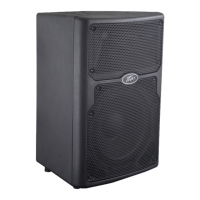40
Loudspeaker System Specifications
Touchup
For an overall finish enhancement and protective coating, use gloves to apply a
plastic finish protector, such as Armor-All® protectant or a similar product, to the
surface of the plastic cabinet only. Note that the cabinet will be slippery after
these treatments; rub them down firmly with a dry, lint-free cloth to minimize this.
Check for Secure Hardware
After the first few months of use and periodically thereafter, check the hardware
of the PVX™p 10 Bluetooth® for tightness, including the rear panel screws and
the screws that hold the baffle and rear cabinet together.
The unit is subject to a great deal of vibration, and this could cause them to
loosen with use.
Architectural and Engineering Specifications
The powered loudspeaker system shall have a frequency response from 65 Hz
to 20 kHz. The peak SPL with inaudible distortion shall reach 123 dB with music
as a source, when measured at a distance of 1M and driven to full output
capacity. The system shall utilize a Peavey® Pro™10 10” heavy-duty woofer and
a Peavey® RX™10 1.0” titanium diaphragm dynamic compression driver. The
nominal radiation pattern shall be 100° in the horizontal plane, and 60° in the
vertical plane. Axis of the vertical main polar lobe is angled down 10 degrees,
resulting in the angular pattern with respect to straight ahead being +20, -40
degrees
The powered, bi-amplified loudspeaker system shall have three input channels
consisting of a medium impedance input connector consisting of one combo
female XLR and 1/4” TRS phone jack for channel 1 and channel 2 on the rear
panel. Channel three shall provide Bluetooth® signal source input control, as
well as doubling as an AUX in for a 1/8" phone jack.
There shall be a output connector consisting of a male XLR jack.
The system power amplifiers shall have
an unfiltered frequency response of 20
Hz to 20 kHz which deviates no more than +0, -3 dB up to rated power, hum and
noise better than 90 dB below rated power, and THD and IMD of less than 0.5%.
The woofer amplifier shall be capable of 160W sine wave power output into a 4
ohm nominal load, and the tweeter amplifier shall be capable of 45W sine wave
power output into a nominal 8 ohm load (with compression and limiting
bypassed), and both shall incorporate independent DSP controlled signal
compression.
The input signal shall be electronically divided into high frequencies and low
frequencies by a fourth order slope line-level crossover at 1.8 kHz. The low
frequencies shall be processed to provide bass boost, subsonic filtering and
overall response shaping, and the high frequencies shall be equalized for
response-shaping.
The enclosure shall be constructed of injection-molded plastic with a UL flame
rating, and reinforcing ribs internally. A handgrip shall be incorporated on the
right side near the woofer and towards the front of the cabinet.

